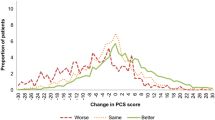Abstract
Background
Many quality of life (QoL) and patient-reported outcomes (PRO) measures have been developed to assess the effects of disease processes and treatments. Although these instruments are valuable, the process is hampered because of their number and lack of interchangeability.
Methods
We identified a cohort of patients across a variety of operations within 3–12 months postoperatively. Patients completed the SF-36, measuring eight domains of QoL (physical functioning, role-physical, role-emotional, bodily pain, vitality, mental health, social functioning, and general health), plus a health transition item: Compared to one year ago, how would you rate your health in general now?. (1) Much better now than one year ago. (2) Somewhat better now than one year ago. (3) About the same as one year ago. (4) Somewhat worse than one year ago. (5) Much worse than one year ago. Additional data included improvement of preoperative symptoms, the occurrence of any postoperative symptoms, and the occurrence of any postoperative complications.
Results
Of 217 patients, 28 % were much better, 28 % somewhat better, 27 % unchanged, 13 % somewhat worse, and 3 % much worse. The health transition results were associated with all SF-36 domains, preoperative symptom change (p = 0.03) and persistent or new postoperative symptoms (p = 0.001), but not postoperative complications. Patients with persistent or new symptoms postoperatively had worse scores in the role-emotional (p = 0.01), bodily pain (p = 0.05), social functioning (p = 0.02), and mental health (p = 0.009) domains of the SF-36.
Conclusions
This single, global assessment of health transition may be a promising practical alternative to assess postoperative patient-centered outcomes. Improved patients had better QoL scores, preoperative symptoms elimination, and no operation-related symptoms, but the occurrence of complications did not affect improvement.


Similar content being viewed by others
References
Birkmeyer JD, Dimick JB, Birkmeyer NJO (2004) Measuring the quality of surgical care: structure, process or outcomes? J Am Coll Surg 198:626–632
Birkmeyer JD, Siewers AE, Finlayson EV et al (2002) Hospital volume and surgical mortality in the United States. N Engl J Med 346:1128–1137
Campbell DA Jr, Englesbe MJ, Kubus JJ et al (2010) Accelerating the pace of surgical quality improvement: the power of hospital collaboration. Arch Surg 145:985–991
Goodney PP, Stukel TA, Lucas FL, Finlayson EV, Birkmeyer JD (2003) Hospital volume, length of stay, and readmission rates in high-risk surgery. Ann Surg 238:161–167
Finlayson SRG, Birkmeyer JD (2007) Critical assessment of surgical outcomes. In: Townsend CM Jr, Beauchamp RD, Evers BM, Mattox KL (eds) Sabiston’s textbook of surgery, 18th edn. Saunders Elsevier, Philadelphia, pp 226–236
Finlayson E, Birkmeyer JD (2009) Research based on administrative data. Surgery 145:610–616
Black N, Jenkinson C (2009) How can patient’s views of their care enhance quality improvement? BMJ 339:b2495
Fung CH, Hays RD (2008) Prospects and challenges in using patient-reported outcomes in clinical practice. Qual Life Res 17:1297–1302
Patient-Reported Outcome and Quality of Life Instrument Database. http://www.proqolid.org. Accessed 8 Jun 2011
Velanovich V (2007) Using quality of life instruments in clinical practice. Surgery 141:127–133
Rose M, Bezjak A (2009) Logistics of collecting patient-reported outcomes (PROs) in clinical practice: an overview and practical examples. Qual Life Res 18:125–136
Ware JE Jr, Snow KK, Kosinski M, Gandek B (1993) SF-36 Health Survey: manual and interpretation guide. The Health Institute, New England Medical Center, Boston
http://www.acsnsqip.org. Accessed 15 Jun 2011
McHorney CA, Kosinski M, Ware JE Jr (1994) Comparisons of the costs and quality of norms for the SF-36 health survey collected by mail versus telephone interviews: results from a national survey. Med Care 32:551–567
Stata Statistical Software: Release 11.0. Stata Corp., College Station, 1985–2009
Lohr KN, Zebrack BJ (2009) Using patient-reported outcomes in clinical practice: challenges and opportunities. Qual Life Res 18:99–107
http://absurgery.org. Accessed 24 May 2011
The SF-12: an even shorter health survey. http://www.sf-36.org/tools/sf12.shtml. Accessed 15 Jun 2011
The SF-8 Health Survey. http://www.SF-36.org/tools/sf8.shtml
Author information
Authors and Affiliations
Corresponding author
Rights and permissions
About this article
Cite this article
Velanovich, V., Younga, J., Bhandarkar, V. et al. A Single, Global Patient-Centered Measure from the SF-36 Instrument to Assess Surgical Outcomes and Quality of Life: A Pilot Study. World J Surg 36, 2045–2050 (2012). https://doi.org/10.1007/s00268-012-1634-9
Published:
Issue Date:
DOI: https://doi.org/10.1007/s00268-012-1634-9




